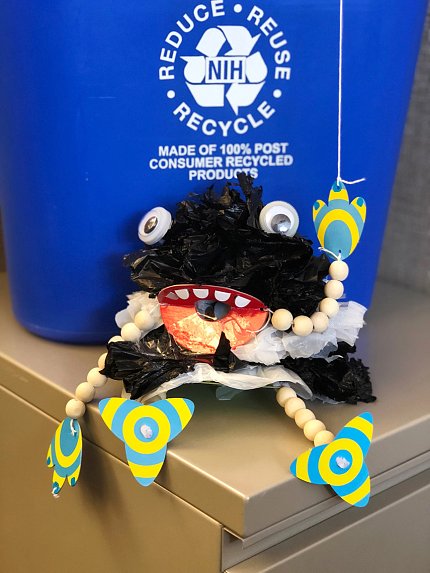April 26
Earth Day Event Addresses Plastic Film Pollution

Photo: Tierra Robinson
The theme for Earth Day 2018 is “End Plastic Pollution.” The Division of Environmental Protection (DEP) is taking a subset of the theme and creating fun activities for children who will visit campus for the joint Earth Day/Take Your Child to Work Day event on Thursday, Apr. 26.
Everyone is encouraged to stop by the DEP table at Natcher Bldg. to feed the Plastic Bag Monster collection container with clean and empty plastic bags that might normally be tossed in the trash. Visitors to the table can also participate in interactive games and win a prize.
Plastic is everywhere. The EPA reports that in 2012, plastics totaled 32 million tons, or 13 percent, of the waste stream. Of this amount, only 9 percent was recycled. Globally, polyethylene (PE) is the most prevalent type of plastic. PE is used to make shrink wraps and other types of thin films, including grocery bags, dry cleaning bags and Ziploc bags. Americans use 100 billion PE bags annually, averaging only 12 minutes of use. However, the lifespan of the bags in landfills and the environment is several hundred years.
The light weight and flexible form of plastic film has its disadvantages. Many bags are blown out of general curbside waste bins or landfills and end up in the environment. Plastic films do not decompose; they photodegrade into microplastics only millimeters wide. These tiny pieces become airborne and get blown into soil, storm drains and waterways. Animals ranging from invertebrates to large marine mammals mistake microplastics for food and ingest them, resulting in negative health effects.
Plastic film has historically found minimal markets. When recycled with other curbside commingled recyclables, the difficult form causes issues at material recovery facilities. Films tend to get snagged and tangled in machinery, causing jams and damage to equipment designed to recover rigid plastics. This degrades processing efficiency and staff safety, while raising labor costs.
Markets for plastic film recycling are on the rise, however. It is suggested that while only 5.4 percent of plastic films are recycled, it is always a cost-effective product to recycle, considering collection, baling and transportation. While it is best to reduce plastics with reuse or substitution, recycling can keep soft plastics out of landfills and the environment. Soft plastics, or plastic film, can be used to create recycled products such as decking, fences, playground equipment, pipes, pallets, crates and new soft plastics.
DEP has been researching ways to incorporate campus-wide plastic film collection through a pilot recycling program started in March 2017.
As a reminder, DEP offers recycling and other waste management consultation for offices and labs located on campus throughout the year. To schedule a consultation for your office or Green Team, call (301) 496-7990 or email NIH recycling coordinator Tierra.Robinson@nih.gov.
